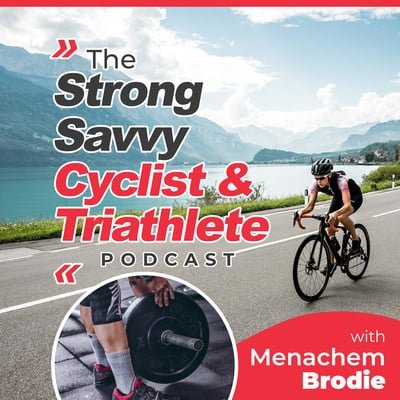Tony Gentilcore is an accomplished Blogger, Writer, Fitness Professional, an aspiring mid-world & Jedi master, who has a soft spot for kittens, and deadlifting.
In part 2 of our conversation Tony and I get into recovery, why most endurance athletes tend to struggle with the mentality needed to see long term success in the weight room for their sport, and much, much more!
Don’t forget to like, share, and subscribe!
In this Episode:
- Introduction
- Yellow Flags in Strength Training
- Earn the Right to Increase Weight
- Go Through a Session Without Increasing Weight
- (De)hydration, Blood Volume, and Performance
- Slow Down!
- Deadlifts
- Conclusion
Show Notes:
0:41 –
Introduction
- Just go to sleep!
- Recovery: why it’s so important and much easier than you think it is
- Deadlifting for endurance athletes
- Why strength training is very different, and why most endurance athletes struggle with it
2:28 –
Yellow Flags in Strength Training
- Lack of motivation to train
- You’re not being overtrained
- You’re tired – just go the fuck to sleep
- No Netflix!
- You’re not being overtrained
- Dr. Quinn Henoch and Dan Pope
- Both talk about training volume and how that needs to be better monitored as far as injuries, motivation to train, etc.
- If you’re doing too much volume of what you can handle of certain movements or load, then you’ll get hurt
- If you have a client or athlete getting hurt a lot, audit your program – your training might be too aggressive
5:07 –
Earn the Right to Increase Weight
- “I do think people need to kinda stay put for more than a week – to kinda earn the right to increase the quota on the bar” – Tony
- People don’t get this
- Each week we either add reps, time under tension, or we’ll go up a weight
- “Training is not linear” – Menachem
- Cyclists that are commonly injured are working too hard in the weight room or too hard on the bike
- Working on breathing patterns is essential
- “It’s not just going up in load every week, but it’s also the recovery in between” – Menachem
8:06 –
Go Through a Session Without Increasing Weight
- Add time under tension or add reps
- People need to be more cognizant of how they feel
- “Recovery – the time in between workouts – is just as important as the actual workout” – Tony
- “I’m very minimalist when it comes to supplements” – Tony
- He likes protein powder, fish oil, vitamin D, creatine, and that’s about it
- You don’t need any of this – just go to sleep!
- It might be unsexy, but it is that simple!
- You don’t need any of this – just go to sleep!
- He likes protein powder, fish oil, vitamin D, creatine, and that’s about it
- “Sleep is important. Eating adequate calories is important. Drinking adequate water.” – Tony
- All of this will affect how your workouts are
- “If you’re dehydrated x amount, your performance in the weight room is going to be compromised” – Tony
- As far as training related stuff, it’s a matter of writing things down and tracking it
- What gets tracked gets managed, and it gives you accountability
- With injury, you have to tinker with that pain threshold a little bit
- People tend to power/plow through pain threshold
- We have to produce a training effect, so let’s do what doesn’t hurt
- Dan Pope says the magic number is a 3 in a pain scale
- 0 = nothing
- 10 = excruciating pain
- During the workout, immediately after, and the day after, you don’t want to be above a 3 as far as dealing with injury
- Mechanotransduction – you have to elicit a little bit of discomfort, but don’t surpass that 3
- Ideally you should move the pain threshold line up, so then you can progress pain-free
17:08 –
(De)hydration, Blood Volume, and Performance
- Decrease in performance with drop in blood volume (in relation to hydration)
- Dr. Stacy Sims said a 2% drop in blood plasma volume will lead to a 8-12% decrease in power for cyclists
- Gatorade and Powerade have very complex carbohydrates
- You want glucose and sucrose in a 3-4% carbohydrate concentrate solution
- You need to water down those drinks because if not it can upset your stomach
- Different types of sodium:
- Sodium chloride (table salt)
- Sodium bicarbonate (baking soda)
- Sodium citrate
- Sodium bicarbonate and citrate will be better absorbed
- Add a teaspoon of baking soda to your sports drink, and it’ll act as a cotransporter to help you bring the water into your system
- Same thing with when you take creatine, you have to drink water, and it’s best absorbed with carbohydrates
- Pain and breathing patterns
- Poor breathing patterns increase ischemia and thus increase pain
- Ischemia = lack of blood flow
- We don’t want to be hard men and women when it comes to the weight room, we want to be smart
- Minimal effective dose
- “Hybrid Athlete” – Alex Viada
- You have to be pretty lazy in the weight room
- You don’t want the intensity of your training to match the intensity of all times that you’re in the weight room
- You have to separate the two
- It’s easy to maintain strength once you get to a certain level
- Balance the body: hinging, rows, obliques, shoulder
- Brad Schoenfeld – muscle hypertrophy study
- You don’t want the intensity of your training to match the intensity of all times that you’re in the weight room
- Poor breathing patterns increase ischemia and thus increase pain
22:15 –
Slow Down!
- Get endurance athletes to appreciate the rest periods
- Repetition
- Common thread: strength training helps and it’ll improve your running economy
- Understand that the intensities don’t always have to match
- You don’t always have to go full throttle the whole time
- “That’s why I’m a big fan of fillers” – Tony
- Filler exercises would be some time of corrective exercises to do during the rest break that won’t affect the subsequent sets
- Low threshold, low effort
- Helps them slow down
- Filler exercises would be some time of corrective exercises to do during the rest break that won’t affect the subsequent sets
- 4 major pillars for athletic progression:
- Hormonal
- Neuromuscular
- Cardio-respiratory
- Metabolic
- Rest periods focus on all of these pillars, which is where strength training can have a great impact
- It’s just repetition – I just hope they follow the program
31:06 –
Deadlifts
- Do you have everyone who comes into your studio deadlift off the floor? Why, or why not?
- Nope!
- “Because they’re not all competitive powerlifters” – Tony
- I think it’s a narrow-minded view of the deadlift
- Tony’s job is to figure out what the best way for you is to perform a deadlift
- You must be able to maintain a neutral spine
- Some people do it off box, trap bar or straight bar, sumo stance or conventional stance, kettlebell or landline
- “They have to earn it” – Tony
- “I wanna train the hip hinge, not necessarily the deadlift” – Tony
- Reduce lumbar extension with minimal knee flexion – essentially what a deadlift is
- It’s not a squat
- There is a squatty hinge
- Reduce lumbar extension with minimal knee flexion – essentially what a deadlift is
- “My initial progression or introduction to the deadlift is typically the trap bar” – Tony
- A more back-friendly way to introduce a loaded hinge
- Stark beginners will sometimes start off with a kettlebell
- Elevating the bar makes it easier as well so that they don’t injure the back and they’re still focusing on the posterior chain
- Cycling back injuries
- A number of these injuries happen in the weight room and are perpetuated from the riding position
- Cyclists have very low bone density if they don’t consistently strength train
- Tissue needs to adapt, which takes so much time
- You need to earn the right to move the weight
38:14 –
Conclusion
- 2 or 3 big things for listeners to remember:
- Train the position that you’re not in
- As far as the bike, training should be in extension not flexion
- Intensity of exercise
- You don’t need to kill yourself in the gym
- It’s more of the 80% effect
- With consistency
- Train the position that you’re not in
- We still need to talk about overhead motion for triathletes
- 2 or 3 movements for cyclists to be focused on in the gym:
- Deadlifts
- Improve T-spine extension
- Gets them access to more shoulder flexion
- Where can people find you?
- The Complete Shoulder and Hip Blueprint
- The Complete Trainers’ Toolbox
- Geared more toward coaches and trainers
- 9 fitness professionals
- Video and webinar format
- 17 hours of content
- CEU credits
- Instagram and Facebook: tonygentilcore
- Twitter: tonygentilcore1
- Tonygentilcore.com – website
- Social media, articles, blogs, etc.
- “Stuff to read while you’re pretending to be working” – really good











